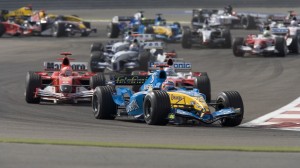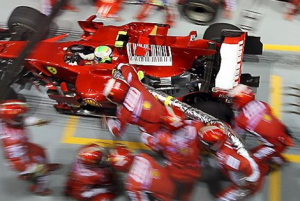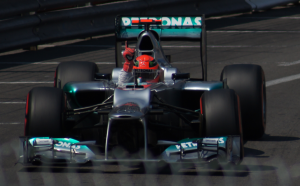The key discussion point among Formula 1 teams, drivers, fans and media in 2013 seems to be tyres. The debate, which started during the course of the 2012 season, is whether Pirelli have got things right with their rubber. There’s barely an expert out there who hasn’t already expressed an opinion; some argue that “Pirelli have done what they’ve been asked to do”, while others think that “this is not real racing”.
Although it might sound contradictory, I actually agree with both statements. For me, it’s not an either or choice between the two extremes. Indeed, I’d argue that the assumption on which the debate is built on – that we need tyres that degrade more quickly in order to spice up the on track action – is a flawed one. Formula 1 can’t take a simplistic view of a problem, as I believe it has done in the past, because the result is likely to be an imperfect solution that could result in further problems. This is precisely the situation that we now find ourselves in.

Fernando Alonso (Renault, Michelin tyres) leads
the 2005 Bahrain GP ahead of Michael
Schumacher (Ferrari, Bridgestone tyres)
To fully understand why we now find Formula 1 in a position where drivers are complaining that they can’t push to the limit of their cars for fear of damaging their fragile tyres we need to look at the recent history of tyres in F1. If we look back to 2005, the penultimate season of the tyre war between Bridgestone and Michelin, we had a situation where tyres had to last the whole race, with no tyre changes allowed during a grand prix (other than because of a puncture, for example). This meant ultra hard and durable tyres and pit-stops only to refuel the car. This resulted in tactical racing driven by fuel strategy.
The one set of tyres per race rule didn’t last beyond the 2005 season, during which we saw the farcical United States Grand Prix at Indianapolis, where only the six cars using Bridgestone tyres were able to start the race due to safety concerns relating to the Michelin tyres at the banked turn 13. Michelin only competed in one further season in Formula 1 before withdrawing from the sport at the end of the 2006 season, leaving Bridgestone as the sport’s sole tyre supplier between 2007 and 2010, when the Japanese firm also withdrew from F1.

Refuelling was banned because of incidents like
Felipe Massa driving off with the fuel hose still
attached at the Singapore GP in 2008
With Bridgestone as the sole tyre supplier the teams effectively got what they were given in terms of tyres. Bridgestone, with no competition, were free to continue to supply durable tyres that produced pretty consistent grip and degraded slowly; a good advertising platform for their road tyres. Unsurprisingly, tyre related pit-stops were few and far between, and refuelling continued to drive tactics and strategy until it was banned from 2010.
This meant that, in Bridgestone’s final year in Formula 1, we had durable tyres, no refuelling, with one pit-stop races very much the norm. As overtaking in Formula 1 was extremely difficult because, for aerodynamic reasons, it was hard for drivers to follow each other closely, we had fairly processional racing. Something had to change, and it did with the arrival of Pirelli as the sports role tyre supplier from the 2011 season.
Pirelli entered the sport with a very clear brief: design, build and supply tyres that degrade more quickly and produce more exciting racing. Pirelli have certainly fulfilled that brief, moving the sport away from the situation it experienced with highly durable Bridgestone tyres following the end of the tyre wars. We now generally see two or three pit-stops for all cars during each grand prix and, because of the different car and driver characteristics, tactics and tyre choices, more overtaking. Overtaking was also boosted by the introduction of the Drag Reduction System (DRS) at the start of 2011, which allows drivers who are within a second of the car in front to reduce drag by opening a flap in their rear wing at designated sections of each track, increasing acceleration and top speed.
So, now we find ourselves in a situation where there is overtaking in Formula 1, but that there is criticism that it is too artificial. DRS certainly receives some of this criticism, but the majority of the flack has been aimed at Pirelli. The Italian tyre manufacturer has, in each of the three years it has been supplying F1 tyres, produced rubber with wear characteristics that are more and more extreme, with drivers having to conserve their tyres, not pushing flat-out for fear that the tyres will “fall off the cliff” – a characteristic where the Pirellis simply run out of grip.
Last season, seven time world drivers’ champion Michael Schumacher described driving on the Pirelli tyres as like driving on “on raw eggs”. He elaborated on this point, explaining that the tyres were, in his view “playing a much too big effect because they are so peaky and so special that they don’t put our cars or ourselves to the limit…I don’t want to stress the tyres at all. Otherwise you just overdo it and you go nowhere”.
The situation is even worse in 2013, with the Mercedes cars of Nico Rosberg and Lewis Hamilton, in particular, struggling with some extreme tyre wear. Mercedes are by no means alone in struggling, though, with Red Bull Racing being quite vocal in stating that the Pirelli tyre wear left them unable to show the underlying pace of their car. Indeed, some of the “overtaking” which has resulted from the faster wearing Pirelli rubber is, in fact, artificial given that drivers are not fighting each other for fear that they will ruin their tyres and cost themselves time. When one driver is effectively waved through by another it’s not really overtaking.
So, returning to the point that I made in my opening paragraph we are in a situation where Pirelli has delivered what they’ve been asked to deliver, but in doing so has given us more overtaking, but artificial racing. Pirelli have clearly gone too far with their 2013 tyres, but the Italian manufacturer is an easy target for critics. If you look beyond the obvious and remind yourself of the sport’s recent history – as I’ve tried to do in this article – you can see why we have arrived where we are now. The real blame, however, must lie with Formula 1’s governing body, the FIA, which sets the sport’s rules.
Surely it would have been better to continue with more durable tyres and introduce a mandatory number of pit-stops in each race, perhaps during specific parts of the race, as has been done in series like GP2. Drivers could race hard, and there would be a guaranteed number of pit-stops in each race to keep things interesting and create opportunities for strategy to be used to facilitate overtaking through pit stop phases of the race. Although this would address the tyre wear issue, the underlying problem in F1 would be unresolved.
As I’ve already mentioned, the fundamental issue with modern Formula 1 cars: their aerodynamic characteristics do not lend themselves to running closely together, meaning that overtaking is incredibly tough. The FIA has come up with “band aid” solutions like DRS and fast wearing tyres without, in my view, addressing this issue. As a result we have racing that is seen as artificial, Formula 1 drivers that are unable to race and push the limits of their machinery, and ridiculous situations like the Pirelli/Mercedes/Ferrari tyre testing controversy that erupted at the recent Monaco grand prix.
All of this is a turn off for F1 fans. Don’t get me wrong, I still wouldn’t miss a race, but I find myself distinctly underwhelmed by the Formula 1 of 2013. Surely it’s not beyond the technical geniuses of Formula 1 to come up with a properly thought out solution to these issues? In any case, the sport will be undergoing some significant changes in 2014 with the advent of the new turbocharged era. I’m looking forward to the unpredictability that the 2014 regulation change will bring, but I do worry that the underlying issues will remain.
Whatever the case, I can’t help but feel that 2013 will be dominated by tyre controversies. With Pirelli’s contract up for renewal at the end of the season, F1 could find itself in a situation where the Italian manufacturer decides to walk away. The sport would only have itself to blame.


